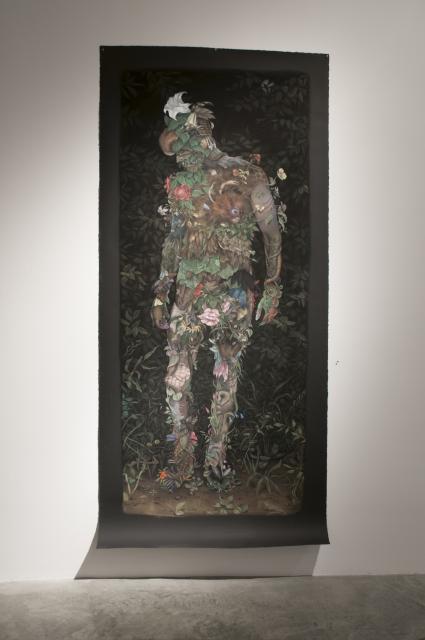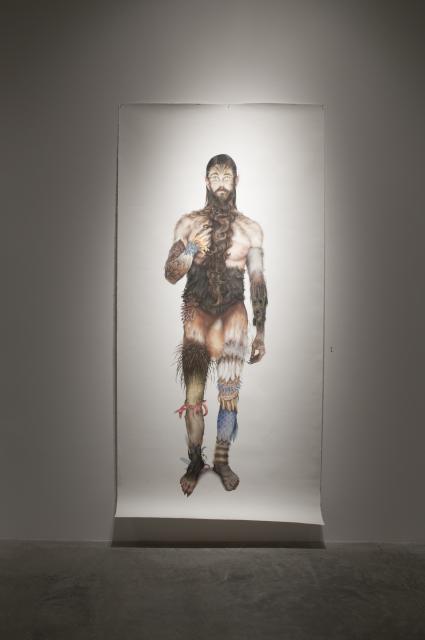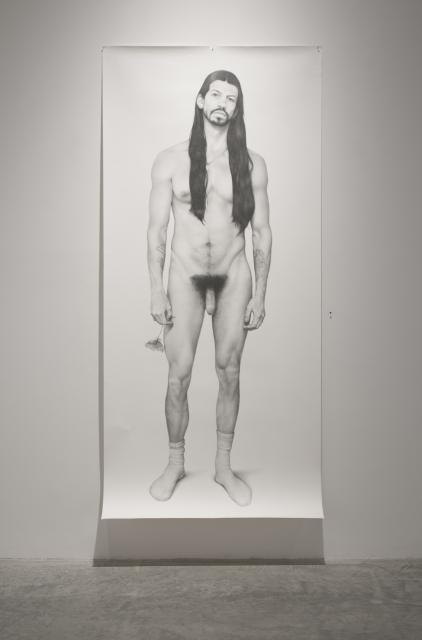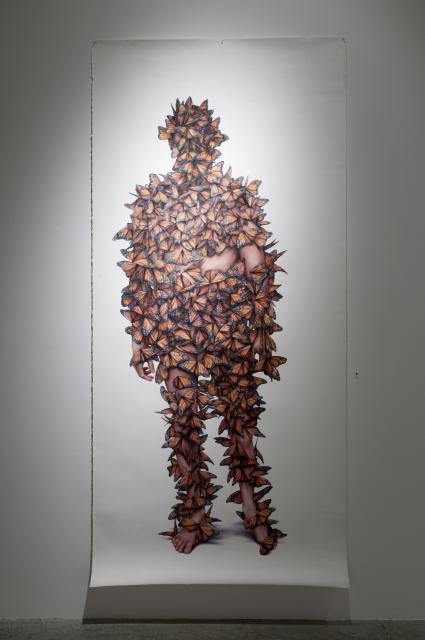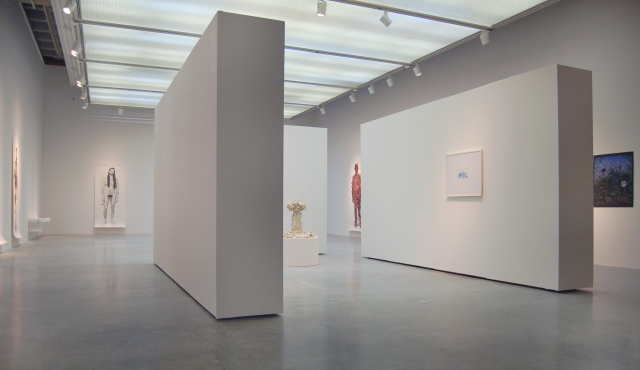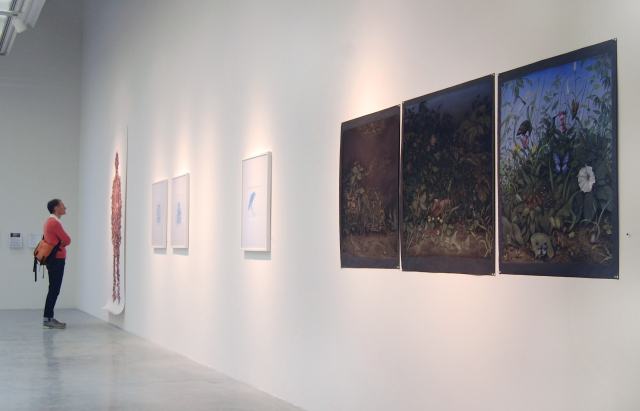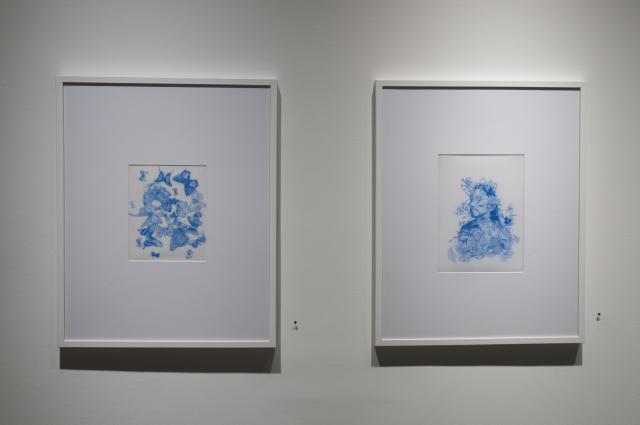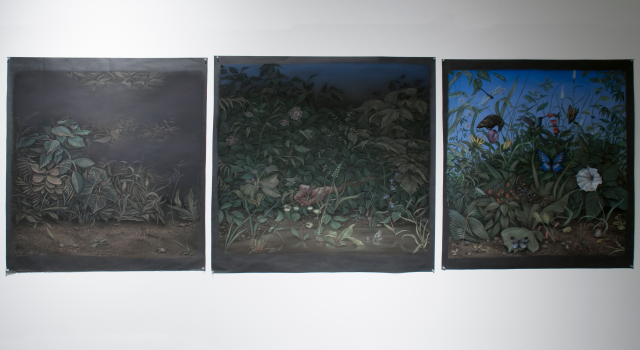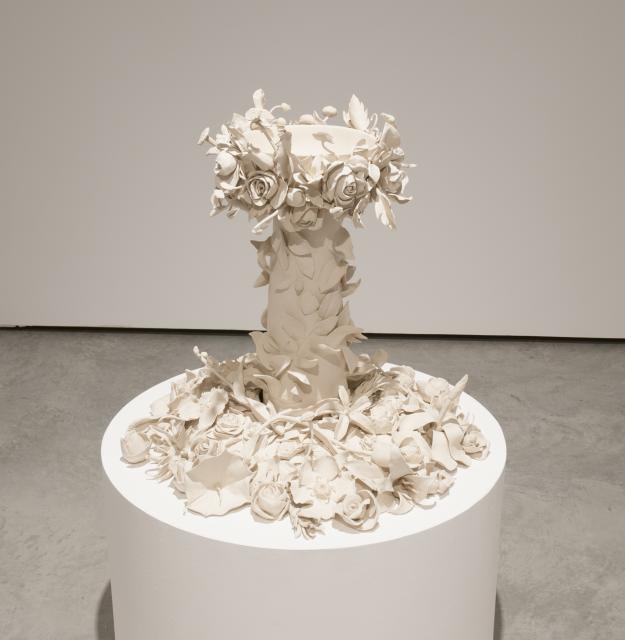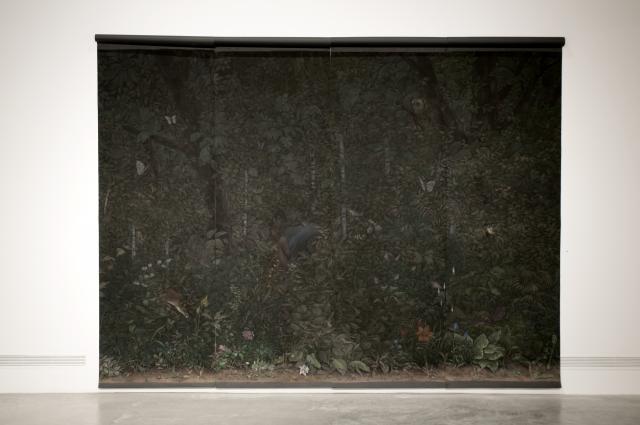
Exhibition
26 Sep 2013 - 26 Oct 2013
Illingworth Kerr GalleryFugitive Garden
Zachari Logan
Saskatoon-based mixed media artist Zachari Logan conducts studio research in ceramics, drawing and installation processes. He works almost exclusively in the area of subjectivity and site to inform and expand the scope of art’s ongoing investigation of originality, authenticity and the transcendental. A starting point for his inquiry is the evolving form of the Universal (or Unified) Man set amid a rapidly disappearing wilderness. The Universal Man is a historical footnote linked to the phenomenon of the educated, multi-talented and worldly Renaissance Man, a near-mythic figure that has all but disappeared in the complex interconnected societies of the 21st century.
Logan does not investigate the attributes of such a figure in contemporary life but rather aims to gather and depict the component parts of the Unified Man, located and entwined imaginatively in Nature. Elaborately detailed, near-photographic replicas of flora and fauna are rendered in blue pencil or pastels. This densely patterned background and foreground imagery is often grafted to the artist’s self-portrait as the ‘Wild Man,’ an alternate mythic figure to that of the Unified Man. A sensual romanticism surrounds Logan’s alignment of the rare homo universalis and the Wild Man. Both imply the unification of Man and Nature, and affirm our imagined collective kinship with all things primitive. The resulting composite images bear a telling similarity to Hieronymus Bosch’s psychologically charged figures set in an unreality and the imaginative work of Pre-Raphaelite artists such as Dante Gabriel Rossetti (and influential follower, William Morris). Fugitive Garden presents 17 recent works that act as a meditation on the fragile merger of Nature and the mythic hybrid human, central subjects in his representation of a regional vernacular.
Logan’s drawings are characterized by a specific approach to self-portraiture that engages with the loss and retention of meaning. He extends the limits of the figurative toward dramatic, novel forms that reframe masculine subjectivity by visually isolating the body or body parts – a hand or a foot emerges from dark foliage, for example. Over the last five years Logan’s representation of his own body has maintained a singular, frontal pose to highlight some aspect or symbol of character, a sign that could portray an idea, identity or an open construction of reality. In many ways Logan has not considered his self-portraits to be traditional in the sense of capturing the visual essence of an individual. Rather, the theatrical “poses” of his depicted body are an imagined world unto themselves, and offer a meditation on impermanence.
Self-portraits may remain the catalyst in Logan’s practice but the body has ceased to be the sole focus. Within Eunuch Tapestry 3 there is a transformative shift in representation that suggests a darker, intuitive mood rather than theatrical extravagance. Entwined within the natural landscape, the body becomes an account of time and place, and thus evokes the weight of identity aligned with a lost, idealized landscape. Through the spectacle of plant and animal life and the ambiguity these manifestations impart, Logan’s figure becomes an integrated spectator, imagining his own body not outside but as an allegorical aspect of Nature.
Logan has applied a coherent method to his query of authenticity in Nature. While the artist’s self-portraits are natural, if idealized, representations of the human figure (which has in time become the classical canon), his depiction of flora and fauna is largely fictive. Tightly juxtaposed, the plants are hybrid and imaginatively formed but not biologically correct. By combining multiple sources of deceptive imagery (from lush riverbank foliage to prairie ditches) within the same picture plane, the portrayed plants and animals represent both the exoticism and nostalgia of place and memory. These landscapes can be said to be largely “internal spaces” for the artist, imagined from the act of observation.
Logan’s inventive representation of empirical reality also involves an artistic strategy of visual quotation. The most recognizable quotation in his work may be the famous Flemish Unicorn Tapestries from the late Middle Ages and now in the collection of The Metropolitan Museum of Art, New York. The seven hangings depict intimate landscapes associated with a hunt for the elusive, magical unicorn. Logan adds a regional twist to The Unicorn Tapestries by altering the title and applying it to his own work (Eunuch Tapestry 3) and by referencing the Canadian prairie, in particular the characteristic ditches that line the sides of rural roads, and the dense greenery of local riverbanks. Logan composes his foreground imagery as a dramatic mimicry of patterned flora not unlike The Unicorn Tapestries. Although the artist is interested in the centuries-old myth of the hunt for this extraordinary animal, beyond the drama of its pursuit he is concerned with its existence as a unique creature. For Logan, the unicorn and its dramatic stage of entwined plant growth are extended as a strong visual metaphor for ideas that investigate queer space and the liminal, as mined from Nature.
One of panels from The Unicorn Tapestries features an elaborately decorated fountain in the middle of the composition. Logan’s ceramic installation makes homage to the single woven fountain while alluding to the historic, decorative centrepieces of parks. Fountain 1 is fired but not glazed so that its colouration mimics off-white, brittle bone matter, a not-so-subtle reference to the absent human figure, ruin and fragmentation. It is an intensely compact fountain and base, its central placement in the gallery a curiosity. Surrounding the bowl are decorative pale flowers, mostly roses, while other wild flowers are assembled around the base, bouquet-like and overflowing. Logan’s Fountain 1 navigates between naturalistic and decorative, similar in intent to the Eunuch Tapestry drawings. The simultaneously flattened and recessive space in his drawings becomes manifested as an in-between space in the sculpture. Fountain 1 creates a similar visual experience: showcasing flowers that are naturalistic in form and shape but devoid of colour, they open a neutral visual space for exploration. It is an important link to other works in the exhibition. According to Logan, “I see the ceramic fountain as a landscape. In many ways it is similar to the drawings, and certainly in the making… it was entirely hand-built – no moulds or pours. In the same way, my drawings are constructed entirely by hand through optical observation.” In this manner Logan insists that his body emerges “democratically” in the drawings, immersed in the flora and fauna, while ambiguous personal narratives co-mingle to establish new relationships between form and meaning. While representation of the artist’s body can remain largely hidden within or beneath the expansive details of foliage, insect or animal life (i.e., Emperor's New Clothes, Green Man), Logan’s figure is accorded a sensuous, intense presence in each composition, continuing the exploration of a fantastical transition zone of the metaphoric as well as the metaphysical.
Images courtesy of the artist and J. Kelly.

